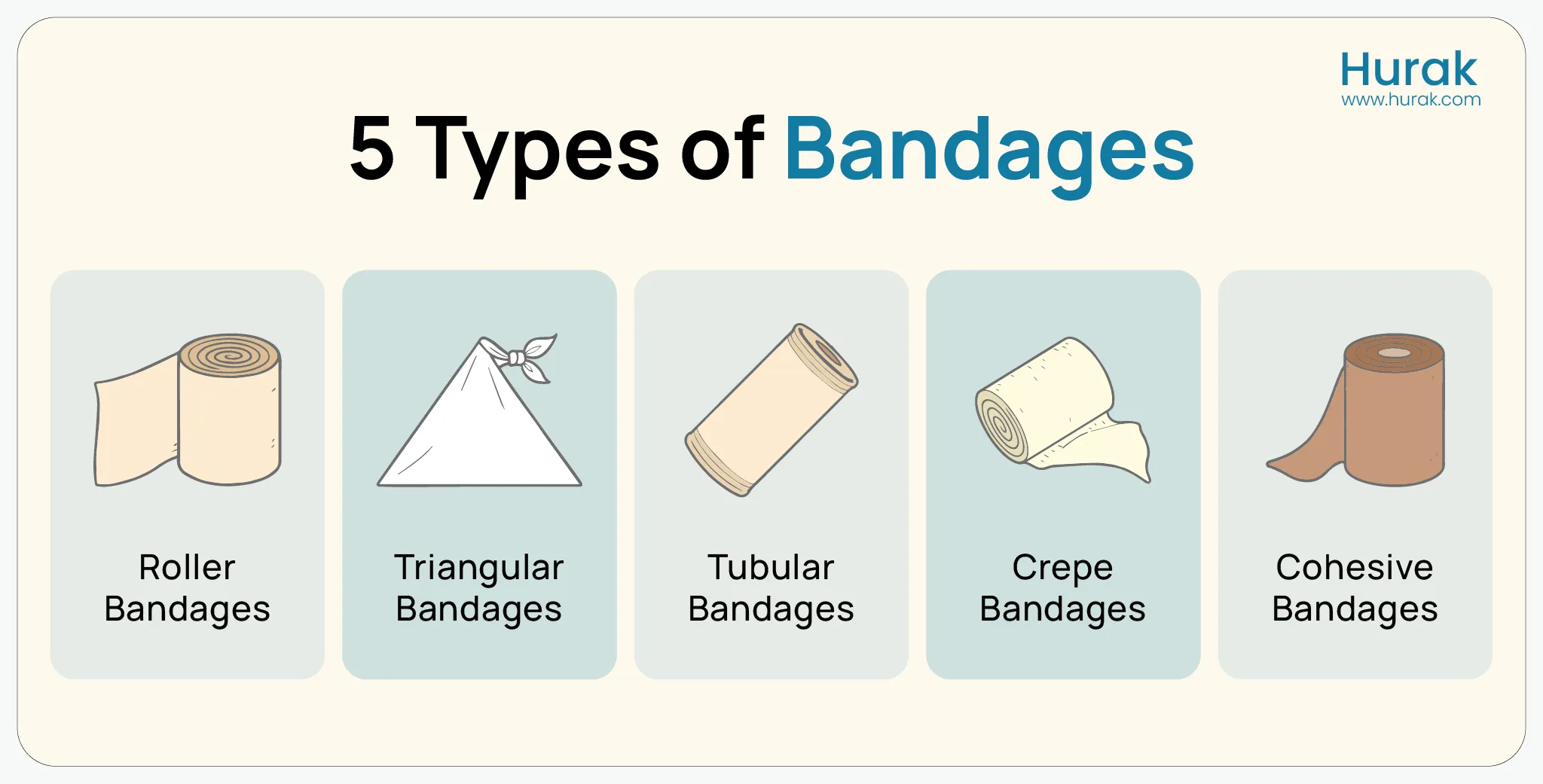
Injuries can happen at any moment, and knowing how to treat them effectively is essential. Bandages are a crucial part of any first aid kit, designed to protect wounds, support injured areas, and encourage healing.
Whether you’re managing a sprain, cut, or other injury, choosing the right bandage is key to providing proper care. With so many different types of bandages available, it’s important to understand their unique purposes.
In this article, we’ll explore the five most important types of bandages and how to use them to provide effective first aid.
Exploring Different Types of Bandages and Their Practical Uses
Not all bandages do the same job. Knowing which one to grab is a crucial step in any first-aid emergency. Here’s a look at the different types and when to use each.

Roller bandages
Roller bandages are flexible and commonly used to secure dressings, support joints, or apply pressure. They’re ideal for covering large areas and are easy to wrap around limbs.
When to use:
- To hold a dressing in place.
- To provide support for a sprain or strain.
- To apply pressure to control bleeding.
- To cover large wound areas on arms or legs.
Triangular bandages
Triangular bandages are adaptable cloths used to support, cover, or immobilise injuries. Their shape makes them especially useful for upper limb injuries.
When to use:
- To create an arm or shoulder sling
- To immobilise a fractured limb
- To secure a dressing on the head or scalp
- As a temporary wrap for splinting
Tubular bandages
Tubular bandages are slip-on coverings designed for fingers, toes, and limbs. They offer light compression and protect minor injuries.
When to use:
- To cover cuts or abrasions on fingers or toes
- To protect dressings on minor wounds
- To provide gentle compression for swelling
- To secure padding on elbows, knees, or other joints
Crepe bandages
Crepe bandages are elastic wraps that provide compression and support for joint or muscle injuries. They help reduce swelling and stabilise affected areas.
When to use:
- To support sprains or strains
- To reduce swelling in sprained areas
- To keep wound dressings in place
- For compression in soft tissue injuries
Cohesive bandages
Cohesive bandages stick to themselves, not the skin, making them ideal for tricky areas. They offer flexible support and compression without the need for clips or tape.
When to use:
- To support sprains and strains
- To wrap joints like wrists, knees, or fingers
- To secure dressings on moving areas
- For compression without adhesive on the skin
Comparison of Bandage Types and Their Uses
Here’s a quick comparison of the five bandage types covered above, summarising their typical uses.
Types of bandages | Uses |
Roller Bandages | Used for securing dressings, providing support, and stopping bleeding. |
Triangular Bandages | Used to create slings, immobilise limbs, or cover wounds. |
Tubular Bandages | Used to cover fingers, toes, and minor injuries for light compression. |
Crepe Bandages | Used for compression, support, and reducing swelling in sprains and strains. |
Cohesive Bandages | Used for compression and support, adheres to itself, ideal for joints. |

Put Your First Aid Knowledge into Practice by enrolling in a course today! Our First Aid courses equip you to handle critical situations and enhance workplace safety. Build confidence and expertise with Emergency First Aid at Work (EFAW) and Level 3 First Aid at Work meeting UK legal requirements.
How to Apply Different Types of Bandages
Each type of bandage has its own special use, and applying them the right way makes all the difference in providing effective care. Whether you’re tending to a small cut or helping someone with a sprain, knowing the best way to use each bandage will help things heal properly. To make sure you’re applying each bandage correctly, refer to the guide below.
Bandage Type | Quick Application Guide |
Roller | Anchor at the far end; wrap toward the body, overlapping each layer by half its width; secure and check circulation. |
Triangular | Fold to the correct width for a sling; place under the limb; tie over the shoulder; tuck or pin ends out of the way. |
Tubular | Slide over the injured area (use an applicator if available); smooth out any wrinkles for a snug fit. |
Crepe | Wrap in a spiral or figure-eight pattern; overlap each layer by one-third of its width; secure and verify circulation. |
Cohesive | Tear to the needed length; wrap so it sticks to itself; press the end down; avoid wrapping too tightly. |
Quick-Reference: 5 Simple Steps to Apply a Bandage
These five steps will help you bandage any minor injury quickly and confidently.
- Clean and dry the wound: Wash your hands, then gently clean the wound with water or a sterile saline solution. Pat the area dry with a clean gauze or cloth.
- Place a sterile dressing: Place a sterile dressing or pad over the wound without touching the side that will contact the skin. Smooth it down so it lies flat.
- Choose the right bandage: Select the appropriate bandage type (roller, crepe, cohesive, etc.) based on the injury location and required support or compression.
- Wrap from the lower end: Anchor your bandage at the point farthest from the heart, then wrap toward the body with even tension, overlapping each turn by about one-third.
- Secure and check circulation: Fasten the end of the bandage (with clips, tape, or by self-adhesion) and then check that the fingers or toes beyond the bandage are warm and pink and have a normal sensation.

Conclusion
Understanding how and when to use different bandages is a key part of effective first aid. Recognising their specific uses and applying them correctly can make all the difference in an emergency. To build your confidence and gain hands-on experience, consider enrolling in one of our First Aid Courses, a valuable step towards being fully prepared when it matters most.
Frequently Asked Questions
What are the 5 types of bandages in first aid?
Roller, triangular, tubular, crepe, and cohesive bandages.
When should I use each type of bandage?
Use a roller for limbs, a triangular for slings, tubular for fingers, crepe for sprains, and cohesive for secure wrapping.
Can I learn bandaging in a first aid course?
Yes, first aid courses teach how to use and apply bandages correctly.
Explore Popular First Aid Courses at Hurak
Looking to boost your skills? Explore our range of first aid courses to find the right one for you.
Here are some of our most popular first aid courses to help you stay prepared:
- Emergency First Aid at Work (1 Day): Get equipped with essential life-saving skills in just one day. This course covers CPR, choking, bleeding control, and how to manage various workplace emergencies, ideal for low-risk environments.
- First Aid at Work (3 Days): A thorough three-day course designed to help you handle a wide range of injuries and illnesses in the workplace. Fully compliant with HSE requirements and perfect for high-risk settings.
- Paediatric First Aid (2 Days): Tailored for anyone working with babies and young children. Learn how to respond to emergencies like choking, febrile seizures, allergic reactions, and more in a childcare context.
- Basic First Aid Course: Great for general awareness outside the workplace. Learn how to treat minor injuries, burns, fainting, shock, and other common incidents.
- Advanced First Aid Training: For those needing a higher level of care. This course covers oxygen therapy, advanced trauma response, and detailed secondary assessments.
- First Aid for Mental Health: Learn how to identify and support individuals facing mental health challenges. Topics include stress, anxiety, depression, and practical early intervention techniques.





